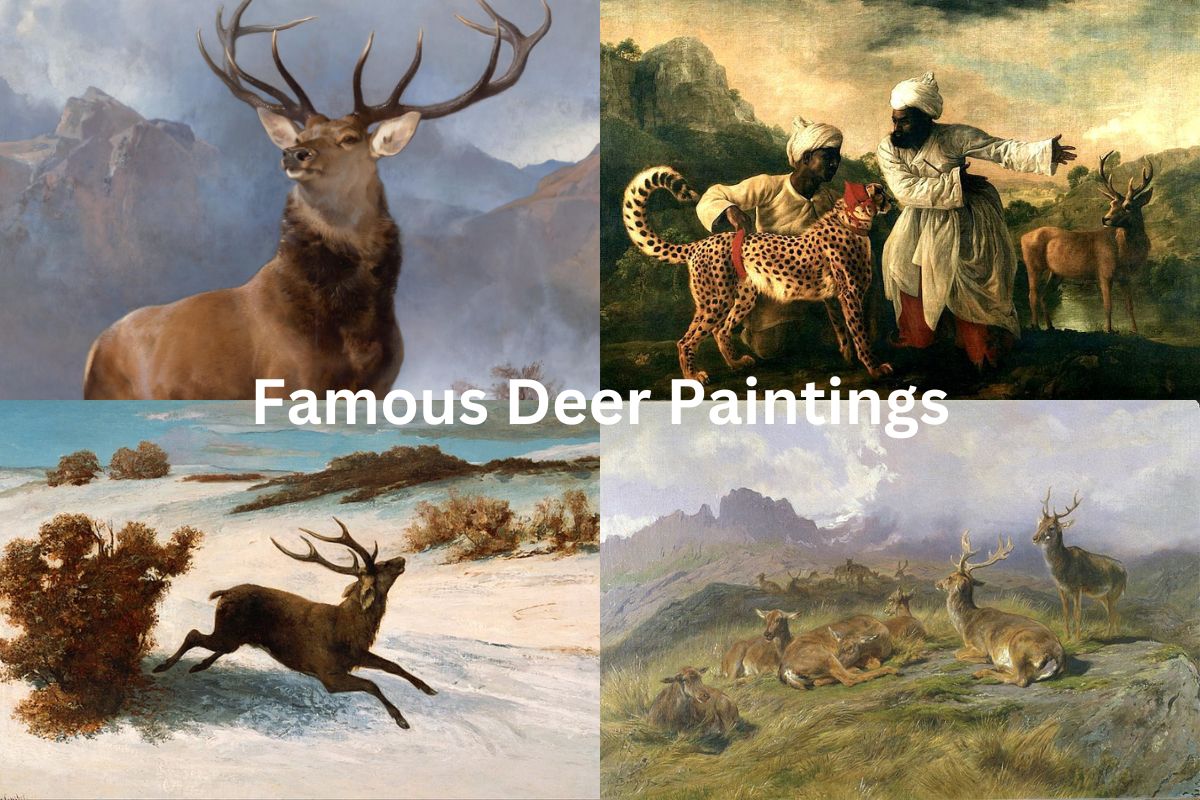Deer have long been a popular subject for artists, appearing in paintings throughout history and across cultures.
Deer are admired for their beauty, grace, and symbolic significance, and they have been depicted in a variety of styles and mediums, from realistic depictions to abstract interpretations.
Deer paintings often convey a sense of tranquility, as these animals are often shown in peaceful natural settings, such as forests or meadows. They can also convey a sense of power and majesty, as seen in paintings of stags with their antlers raised in dominance.
Famous deer paintings include works by artists such as Sir Edwin Landseer, Rosa Bonheur, George Stubbs, and Gustave Courbet, among many others. These paintings have become iconic examples of wildlife painting, and they continue to inspire artists and viewers around the world.
Famous Deer Paintings
1. Deer in the Forest – Franz Marc
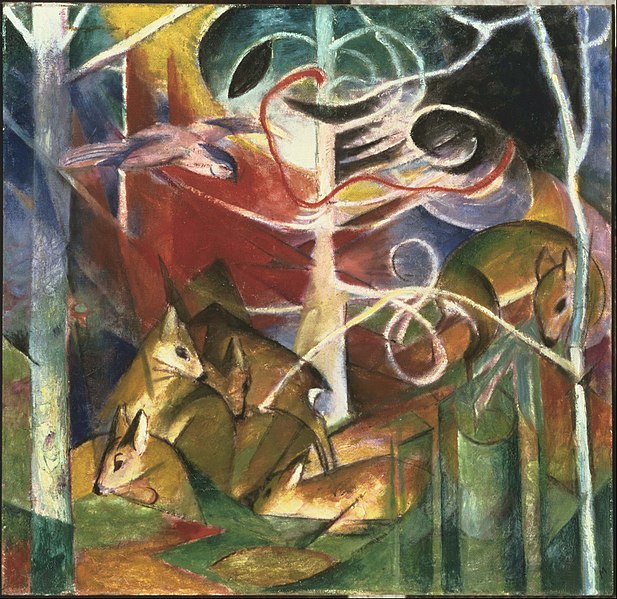
“Deer in the Forest I” is a famous painting by the German expressionist artist Franz Marc. The painting was created in 1913 and is part of a series of works by the artist that explores the beauty and vitality of nature.
In the painting, Marc depicts a group of deer in a lush forest setting. The deer are rendered in bold, bright colors, which contrast with the deep greens and browns of the forest. Marc was known for his use of color to convey emotion and mood, and this painting is a prime example of his skill in this regard.
The deer themselves are shown in a stylized manner, with elongated limbs and curved bodies. Marc was influenced by the work of the French painter Paul Cézanne, who sought to break down the traditional forms of representation in art. Like Cézanne, Marc was interested in exploring the underlying geometry of the natural world.
“Deer in the Forest I” is considered one of Marc’s most important works, and it has become an iconic image of the German Expressionist movement.
2. The Wounded Deer – Frida Kahlo
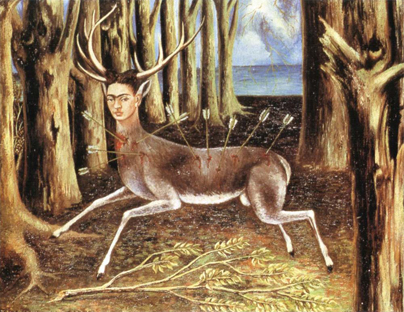
“The Wounded Deer” is a famous painting by Mexican artist Frida Kahlo, completed in 1946. The painting is a self-portrait, and it depicts Kahlo as a wounded deer, pierced by arrows and bleeding. The painting is often interpreted as a symbol of Kahlo’s physical and emotional pain.
In the painting, Kahlo’s head is replaced by that of a deer, with antlers sprouting from her forehead. Her body is shown naked and vulnerable, with arrows piercing her flesh. The background of the painting is a barren landscape, with a stormy sky overhead.
Kahlo was known for her highly personal and emotional art, which often reflected her experiences with physical and emotional pain. She suffered from a number of health problems throughout her life, including polio as a child and a bus accident that left her with lifelong injuries.
“The Wounded Deer” is one of Kahlo’s most famous works, and it is now housed in the collection of the Museum of Modern Art in New York. The painting has become a powerful symbol of resilience and strength in the face of suffering, and it continues to inspire artists and viewers around the world.
3. The Hunt in the Forest – Paolo Uccello
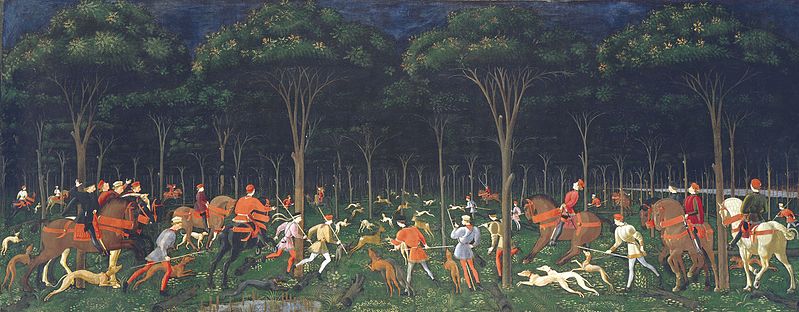
“The Hunt in the Forest” is a famous painting by Italian Renaissance artist Paolo Uccello, completed in 1470. The painting depicts a group of hunters on horseback, with their hounds and falcons, chasing a stag through a forest.
The painting is notable for its dynamic composition and use of perspective. Uccello was one of the first artists to use linear perspective in his work, and “The Hunt in the Forest” is a prime example of his skill in this regard.
The painting features a series of converging lines that lead the viewer’s eye deep into the forest, creating a sense of depth and space.
The figures in the painting are rendered in a stylized manner, with elongated limbs and exaggerated gestures. Uccello was known for his interest in mathematics and geometry, and this is reflected in the precise, almost mechanical quality of his figures.
“The Hunt in the Forest” is considered one of Uccello’s most important works, and it is now housed in the Ashmolean Museum in Oxford, England. The painting has become a classic example of Renaissance art, and it continues to inspire artists and viewers around the world.
4. The Vision of Saint Eustace – Annibale Carracci
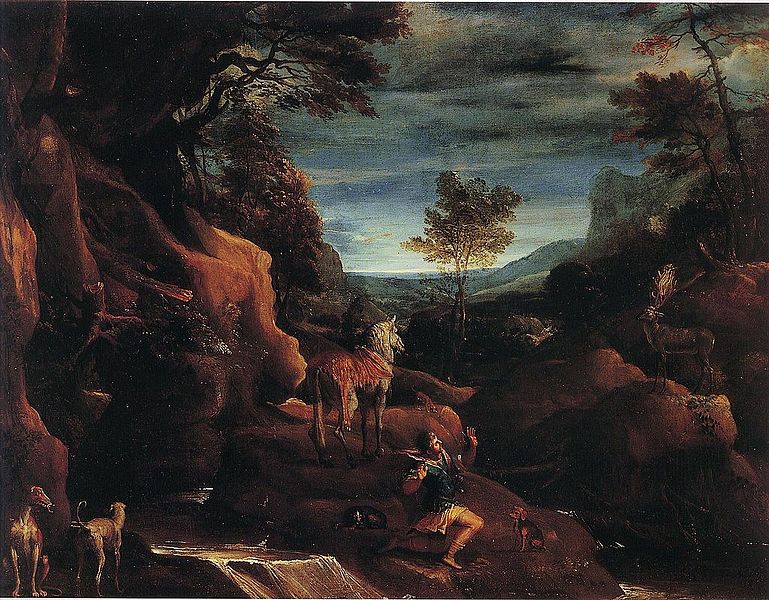
“The Vision of Saint Eustace” is a famous painting by Italian Baroque artist Annibale Carracci, completed in 1615. The painting depicts the legendary story of Saint Eustace, who was a Roman general named Placidus before his conversion to Christianity.
According to the story, Placidus was out hunting one day when he saw a vision of a crucifix between the antlers of a stag. He heard a voice telling him that he would suffer greatly for his faith, but that he would ultimately be saved.
Placidus was so moved by the vision that he and his family converted to Christianity and changed their names to Eustace and his wife Theopista.
In Carracci’s painting, Saint Eustace is shown kneeling before the crucifix, with the stag and his family nearby. The composition of the painting is complex and dramatic, with a sense of movement and tension created by the placement of the figures and the use of light and shadow.
Carracci was known for his skill in creating grand, monumental paintings that combined elements of classical art with the drama and emotion of the Baroque period.
“The Vision of Saint Eustace” is considered one of his most important works, and it is now housed in the National Museum of Capodimonte in Naples. The painting has become an iconic example of Baroque art, and it continues to inspire artists and viewers around the world.
5. The Monarch of the Glen – Sir Edwin Landseer
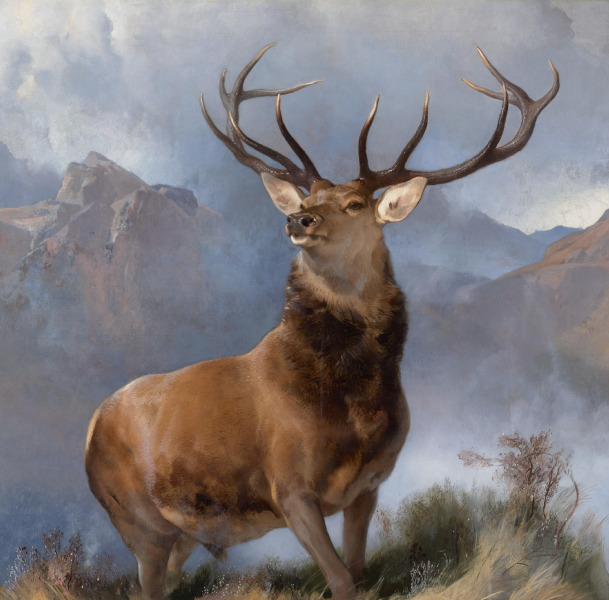
“The Monarch of the Glen” is a famous painting by Scottish artist Sir Edwin Landseer, completed in 1851. The painting depicts a majestic stag standing proudly on a rocky outcrop in the Scottish Highlands.
The painting is notable for its dramatic composition and attention to detail. Landseer was known for his skill in rendering animals, and “The Monarch of the Glen” is a prime example of his ability to capture the majesty and power of the natural world. The stag is shown in intricate detail, with its antlers and fur rendered in a highly realistic manner.
“The Monarch of the Glen” has become an iconic image of Scottish culture, and it is widely recognized as one of the most famous animal paintings in the world. The painting has been reproduced in a variety of forms, including on clothing, home décor, and even on bottles of whiskey.
In recent years, there has been some controversy surrounding the painting, with some critics arguing that it romanticizes the hunting of wild animals.
However, others argue that the painting celebrates the beauty and power of nature, and that it remains an important cultural icon in Scotland and beyond. The painting is now housed in the National Museum of Scotland in Edinburgh.
6. Red Deer Stag and Hind – George Stubbs
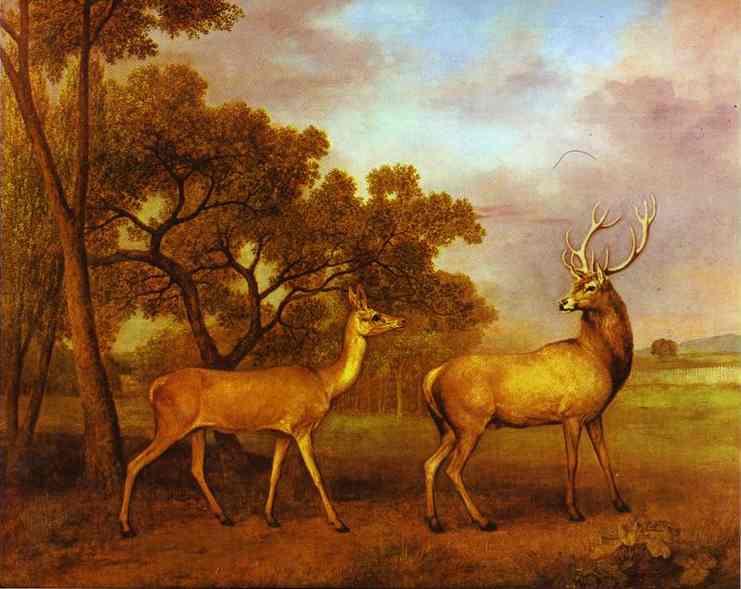
“Red Deer Stag and Hind” is a famous painting by British artist George Stubbs, completed in 1764. The painting depicts a pair of red deer, a stag and a hind, in a naturalistic landscape setting.
Stubbs was known for his interest in anatomy and the natural world, and his paintings often focused on animals in motion. In “Red Deer Stag and Hind,” the animals are shown in a lively and dynamic pose, with the stag rearing up on its hind legs and the hind looking on attentively.
The painting is notable for its attention to detail, with each animal carefully rendered to show its individual features and movements. The landscape itself is also highly realistic, with a sense of depth and space created by the use of atmospheric perspective.
“Red Deer Stag and Hind” is now housed in the Tate Britain museum in London, and it remains one of Stubbs’ most famous and influential works. The painting has become an iconic example of British wildlife painting, and it continues to inspire artists and viewers around the world.
7. Landscape with Deer – Rosa Bonheur
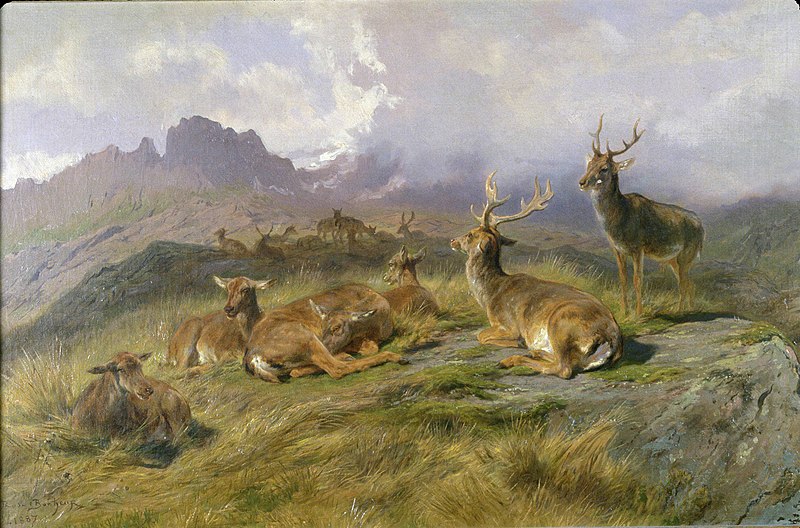
“Landscape with Deer” is a famous painting by French artist Rosa Bonheur, completed in 1868. Bonheur was one of the most famous female artists of the 19th century, known for her realistic depictions of animals and landscapes.
In “Landscape with Deer,” Bonheur depicts a group of deer grazing in a picturesque landscape. The painting is notable for its attention to detail, with each deer carefully rendered to show their individual features and movements.
The landscape itself is also highly realistic, with lush greenery and a sense of depth and space created by the use of atmospheric perspective.
Bonheur was known for her interest in animals and the natural world, and her paintings often focused on these subjects. She was also a trailblazer for women in the art world, achieving great success and recognition at a time when female artists were often overlooked.
8. Cheetah and Stag with Two Indians – George Stubbs
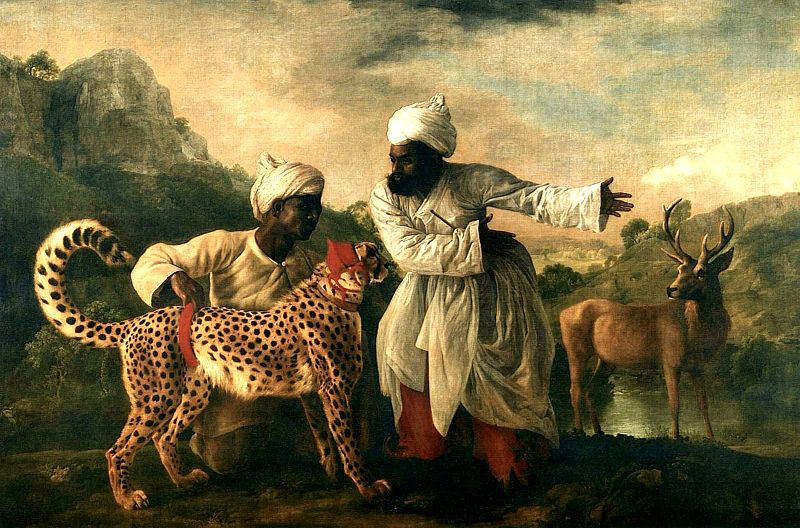
“Cheetah and Stag with Two Indians” is a famous painting by British artist George Stubbs, completed in 1765. The painting depicts a cheetah on a leash, held by two Indian men, chasing a stag through a naturalistic landscape.
Stubbs was known for his interest in animals and the natural world, and his paintings often focused on the anatomy and movements of animals.
In “Cheetah and Stag with Two Indians,” he captures the drama and excitement of a hunting scene, with the cheetah and stag shown in dynamic poses.
The painting is notable for its attention to detail, with each animal carefully rendered to show its individual features and movements. The landscape itself is also highly realistic, with a sense of depth and space created by the use of atmospheric perspective.
9. Deer Running in the Snow – Gustave Courbet
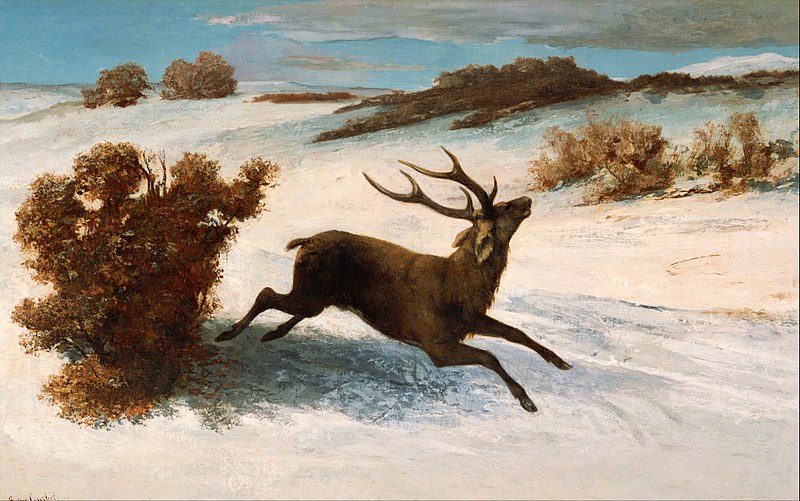
“Deer Running in the Snow” is a famous painting by French artist Gustave Courbet, completed in 1861. The painting depicts a lone deer running through a snowy landscape.
Courbet was known for his interest in realism, and “Deer Running in the Snow” is a prime example of his skill in capturing the beauty and power of nature. The deer is shown in a naturalistic manner, with it’s movements and expressions carefully observed and rendered.
The painting is notable for its use of color and texture. Courbet used a thick impasto technique to create a sense of texture and depth in the snow and trees, and he used a subdued color palette to convey the cold, wintry atmosphere of the scene.
10. Fallow Deer – Richard Ansdell
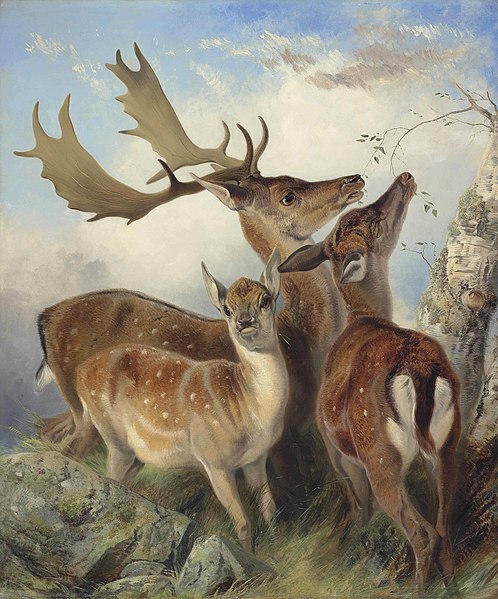
“Fallow Deer” is a famous painting by British artist Richard Ansdell, completed in 1861. The painting depicts a group of fallow deer in a forest setting, with a buck in the foreground and several does and fawns in the background.
Ansdell was known for his skill in rendering animals, and “Fallow Deer” is a prime example of his ability to capture the beauty and power of the natural world. The deer are shown in a naturalistic manner, with their movements and expressions carefully observed and rendered.
The painting is notable for its use of light and color. Ansdell was a master of light and shadow, and he used these elements to create a sense of depth and atmosphere in his paintings. In “Fallow Deer,” the dappled sunlight filtering through the trees creates a sense of warmth and tranquility.

